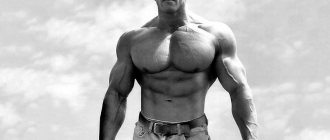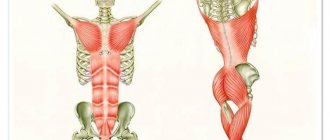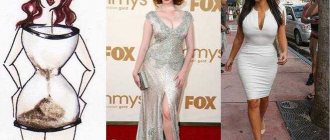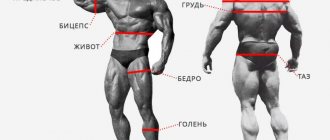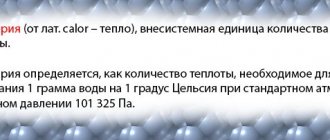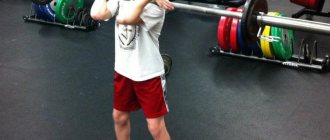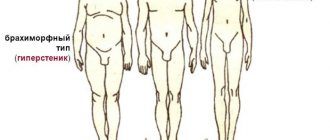Around 1490, the great Italian scientist, artist, and sculptor Leonardo da Vinci drew his famous drawing “The Vitruvian Man.” This design is often used as a symbol of the symmetry of the human body. It depicts the figure of a naked man in two superimposed positions: with arms and legs spread to the sides, inscribed in a circle; with arms apart and legs brought together, inscribed in a square. The drawing and its explanations are sometimes called canonical proportions. The significance of this drawing is difficult to overestimate. After all, proportions are a means of creating a harmonious image not only for architects, artists, designers, but also for clothing designers.
Leonardo da Vinci's theory of proportionation
The meaning of the “Vitruvian Man” is that only the ideal proportions of the human body make it possible to fit a position with arms and legs apart into a circle, and with arms and legs apart into a square. However, the theory of proportionation itself (Leonardo da Vinci only embodied it in a drawing) was created by another Roman scientist and architect - Marcus Vitruvius Pollio. Later, this theory became widespread in fine arts and architecture.
According to this theory, the following ratios are characteristic of the ideal proportions of the human body:
- » the length from the tip of the longest to the lowest base of the four fingers is equal to the palm
- » a foot is equal to four palms
- » a cubit is equal to six palms
- » the height of a person is four cubits (and accordingly 24 hands)
- "A step is equal to four cubits
- » the span of human arms is equal to its height
- » the distance from the hairline to the chin is 1/10 of its height
- » the distance from the top of the head to the chin is 1/8 of its height
- » the distance from the top of the head to the nipples is 1/4 of its height
- » maximum shoulder width is 1/4 of its height
- » the distance from the elbow to the tip of the hand is 1/4 of its height
- » the distance from the elbow to the armpit is 1/8 of its height
- » arm length is 2/5 of its height
- » the distance from the chin to the nose is 1/3 of the length of his face
- » the distance from the hairline to the eyebrows is 1/3 of the length of his face
- » ear length 1/3 face length
- » Proportionality calculator
- » Grace Calculator
- » body mass index
- » Fitness calculator
How to take measurements correctly
Before the procedure, the subject is told what is included in anthropometry. The information creates an adequate understanding of the analysis. During anthropometry, measurements are taken:
- wrists;
- forearms (1-2 cm from the elbow);
- biceps (when bending the arm at the elbow);
- neck (under the fold of the Adam's apple);
- shoulder girdle (through the top of the pectoral muscles);
- breasts (2-3 cm from the nipples);
- abdomen (above the navel);
- pelvis (in the middle of the gluteal muscles);
- thighs (in the widened part of the leg);
- ankles (above the feet with legs bent).
Measurements are required by both professional and amateur athletes. The indicators demonstrate the level of body development and the effectiveness of training. Standing and sitting height, weight, and hand strength are measured using a dynamometer.
To undergo anthropometry, please contact the International Center for Health Protection. Doctors will take measurements using medical standards. They will make calculations and issue a conclusion. The cost of anthropometry is low: the examination is available to everyone. When athletes undergo an in-depth medical examination, anthropometry is included in the examination program. To make an appointment, call or fill out an application on the website. Operators will contact the patient and determine the time of the visit.
Master class “Choosing a wardrobe according to your body type”
| In this master class: | |
| Rules for choosing a wardrobe for 6 body types | |
| How to choose a dress, blouse, skirt, trousers according to your figure | |
| How to choose a jacket and outerwear | |
| Selection of texture and fabrics | |
| Current models of items in the wardrobe | |
| What things should you avoid? | |
PASS FOR FREE
Proportions of the human figure. Ideal proportions of women, men, children, old people
Human figure proportions
The proportions of the human figure have interested artists, philosophers and educators over the past 20 centuries and more. The Roman architect Vitruvius wrote at the beginning of the 1st century AD: “Nature has shaped the human figure so well that the face, from the chin to the roots of the hair, is a tenth of the whole body.” He also argued that the navel is the center of the body, so a circle drawn around this point would touch the outstretched fingers and toes of a person lying on his back. It was this theory that was illustrated in the famous drawing by Leonardo da Vinci , presented below.
Unfortunately, the theory only works in practice if the hands are at a very specific angle . However, you can notice that when the arms are extended to the sides, the distance between the tips of the fingers is approximately the same as between the top of the head and the soles of the feet. This is a useful rule when determining arm length.
During the Renaissance, human anatomy became the subject of detailed study, and artists became involved in the search for meaningful mathematical relationships between the sizes of different body parts. Comprehensive approaches have been invented to determine the “ ideal figure ”. Since then, hundreds of such approaches have been developed using various parts of the body as units of measurement, including the head, face, legs, forearms, index finger, nose, spine, and so on. But, since no approach was universal , because... There is no denying the obvious fact that all people are different, these approaches are of interest only to the classics. The accepted ideal proportions of the figure also change from one generation to another. Therefore we must generally resort to observing a wide range of sizes and shapes of the people we see around us.
For our purposes, however, it is useful to study the average sized figure , as this gives us a base from which to build proportions .
The most common method is to use head height as a unit of measurement for relative measurements of different body parts. The average figure is seven heads , but a range between six and eight heads is also considered normal. In fact, most often in drawing guides the "ideal" figure is depicted as being eight heads tall - mainly, I suspect, because then the body can be divided vertically into eight convenient sections: chin, nipples, navel, crotch, mid-thigh, knees , calves and feet, which makes the instructor’s life easier!
However, rules are made to be broken! We can admire the remarkable achievements of Roman architects and Renaissance artists/mathematicians, all of which should offer us a convenient test of proportions, but it would be foolish to limit ourselves to this method.
Children's proportions
When drawing children, you will find that the head takes up a much larger proportion of the total height . The head of a newborn baby is about a quarter of the total height, and the length of the legs is much less. But as the child grows, the legs increase in length much more than other parts of the body in relation to the overall height of the body, so that the head becomes proportionately smaller.
Get 10 free video lessons
Ten free video lessons from the Kalacheva School drawing school are available immediately after registration.
Using promo code REFPART
— 10% discount on all courses with teacher verification until the end of 2022!
Get
Distribution of subcutaneous fat
During childhood, male and female body shapes are very similar. The average adult male's body shape is primarily dictated by the size of his muscle mass, while the average woman's body shape is determined primarily by the size of her fat mass. When girls reach puberty, there is an increase in fat deposits in very specific places to give the roundness of the breasts and hips of an adult woman.
Below are illustrations of where subcutaneous fat is deposited in women and men . Both sexes have reserves high on the back between the shoulder blades, which show up in obese people of both sexes with hunched shoulders and a short neck. However, other places where fat accumulates are different between the sexes. A man's excess weight is more characteristic of his waist than his hips. Excess fat in men is stored above the hip bone at the back on either side of the spine and on the upper abdomen. Overweight women , on the other hand, tend to gain more on their hips than on their waist. Their main fat storage areas are the lower abdomen, buttocks and thighs, as well as the chest and back between the shoulder blades, just like men.
Fat distribution in women
Male fat distribution
Proportions of elderly people
In old age flexor muscles tend to contract and become shorter. This makes the body bend when it is in a normal standing position. The shoulders are rounded, the natural curve of the thoracic spine increases, and the neck pushes the face forward. Even when the body is relaxed, the arms and legs remain slightly bent.
The skin and subcutaneous fat become thinner and the muscles contract. Elbows and wrists appear larger, and veins may become visible and protrude from the skin. All fat deposits on the body and face become softer and tend to sag at the elbows and under the chin.
From the next lesson we move on to the practice of drawing a person .
I hope you enjoyed this tutorial! Leave your comments and remarks about the course “How to Draw a Person” .
The article used materials from the books: - Ron Tiner “Figure Drawing without a model”; — Loomis E. Nude. Drawing Guide.
Drawing ideas for every day
